Red Hat Technology & Roadmap
Slide 1

Slide 2

Introduction Lynne Corddry (lcorddy@redhat.com) Vice President, Business Development Tim Demski (tdemksi@redhat.com) Director, Business Development Shawn Wells (swells@redhat.com) Government Solutions Architect 2
Slide 3

Agenda Red Hat Enterprise Linux Update SOA Direction / Application Stack Future Direction (Emerging Technologies) Summary & Close 3
Slide 4

Red Hat, Inc Headquarters: Raleigh, NC Founded 1993 Public 1999 (NYSE: RHT) Operating in 27 countries Over 2800 Employees worldwide Over 50% are engineers $1.3B cash reserves $400M FY07 Revenue 4
Slide 5

5
Slide 6

Quarterly Revenue $111.1 $105.8 $99.7 $65.7 $73.1 $78.7 $118.9 $127.3 $135.4 $84.0 2Q06 3Q06 4Q06 1Q07 2Q07 3Q07 4Q07 1Q08 2Q08 3Q08 In millions 6
Slide 7

Red Hat & LMCO Master Partner Agreement At IS&GS Level Major participant in LMCO labs (NEXGEN, LIGHTHOUSE) Web Services Factory Partner on major programs NGA GEOSCOUT NASA ORION Air Force TMOS and GCSS NAVY Q70 ARMY WIN-T FBI NGEN 7
Slide 8

Visit http://www.redhat.com/promo/vendor for more information 8
Slide 9

BEA WebLogic Veritas VMWare EMC Powerpath SUN Solaris 9
Slide 10

Red Hat Development Model 10
Slide 11

Red Hat Enterprise Linux Update Virtualization
Slide 12

Virtualization Problem Model Solution 12
Slide 13

Virtualization: Define the Problem APP OS APP 30% Utilized HARDWARE APP OS APP 50% Utilized HARDWARE 13
Slide 14

Virtualization: Modeling the Problem via Xen dom0 domU domU (Privileged Guest OS) (Regular Guest OS) (Regular Guest OS) XEN Hypervisor HARDWARE (CPU, RAM, devices) 14
Slide 15

The Xen Hypervisor Advantages ● Flexible IT Services ● Disaster Tolerance ● Life Cycle Management ● Live Migration Disadvantages ● Power Management ● 2x Privileged Entities Options ● Fully Virtualized ● Para Virtualized 15
Slide 16

Virtualization: Modeling the Problem via KVM RHEL with KVM Module Device Driver Guest Device Driver Guest CPU & RAM HARDWARE (CPU, RAM, devices) 16
Slide 17

The Xen Hypervisor The KVM Hypervisor Advantages ● 80-100% Native Performance ● Specjbb2005: 95-100% Native Performance ● Stable Advantages ● One Privileged Entity ● All Advantages of RHEL ● KVM in Upstream Kernel Disadvantages ● Power Management ● 2x Privileged Entities Disadvantages ● Not production worthy, target RHEL6 ● CPU Intensive, 50-100% Options ● Fully Virtualized ● Para Virtualized Future ● Xen guests compatible with KVM 17
Slide 18

18
Slide 19

Introduction to virt-manager Graphical virtual guest management Add/Remove resources dynamically Live performance graphs Graphical & Serial Console Emulation Connect to remote hosts 19
Slide 20

Introduction to libvirt API Hypervisor agnostic Stable API for tool/app development CIM providers; Python, C bindings, scriptable Allows authenticated/encrypted sessions to remote hypervisors Current support for Xen Hypervisor KVM Hypervisor QEMU Hypervisor 20
Slide 21

ADMIN NODE Introduction to oVirt oVirt Web GUI Currently in development FreeIPA Utilizes libvirt Web-Based GUI Automate clustering, load balancing, and SLA maintenance Designed for enterprise management DNS/DHCP/TFTP ISCSI Storage NODE 1 NODE 2 Guest 1 Guest 3 Guest 2 Guest 4 Built on Ruby on Rails Performance tools built-in 21
Slide 22

Red Hat Enterprise Linux Update Security
Slide 23

Open Source as a Security Innovation 1. More eyes on the code, therefore less security bugs 2. Red Hat’s rapid response to any vulnerabilities Time from a critical issue being known to the public until the day that a fix is available via RHN Red Hat Enterprise Linux 4, Feb 2005-Feb 2006 23
Slide 24

Red Hat Security Certifications ● ● ● ● ● NIAP/Common Criteria: The most evaluated operating system platform ● Red Hat Enterprise Linux 2.1 – EAL 2 (Completed: February 2004) ● Red Hat Enterprise Linux 3 EAL 3+/CAPP (Completed: August 2004) ● Red Hat Enterprise Linux 4 EAL 4+/CAPP (Completed: February 2006) ● Red Hat Enterprise Linux 5 EAL4+/CAPP/LSPP/RBAC (Completed: June 2007) DII-COE ● Red Hat Enterprise Linux 3 (Self-Certification Completed: October 2004) ● Red Hat Enterprise Linux: First Linux platform certified by DISA DCID 6/3 ● Currently PL3/PL4: ask about kickstarts. ● Often a component in PL5 systems DISA SRRs / STIGs ● Ask about kickstarts FIPS 140-2 ● Red Hat / NSS Cryptography Libraries certified Level 2 24
Slide 25

RHEL5 Security: DoD Access Cards 25
Slide 26

RHEL5 Security: NIST Standards Work Extensible Configuration Checklist Description Format (XCCDF) Enumeration for configuration requirements DISA FSO committed to deploying STIG as XCCDF Others working with NIST Security policy becomes one file 26
Slide 27

RHEL5 Security: Basics of SELinux 27
Slide 28

RHEL5 Security: SELinux Policies Targeted Policy (Default) Applications run unconfined unless explicitly defined policy exists Strict Policy All application actions explicitly allowed through SELinux, else actions denied MLS Polyinstantiated file systems Allows for different “views” based on clearance level 28
Slide 29

RHEL5 SELinux Enhancements ● ● Expanded SELinux targeted policy coverage ● Provides coverage for all core system services, versus 11 in Red Hat Enterprise Linux 4 ● Includes support for Multi Level Security (MLS) enforcement model ● In addition to existing RBAC and TE models An additional level of protection against security exploits ● Fine-grained policies via kernel-enforced mandatory access controls ● Limits the scope of security vulnerabilities ● Beyond what any other general-purpose OS can deliver 29
Slide 30

RHEL5 SELinux Enhancements ExecShield This enhancement can prevent any memory that was writable from becoming executable. This prevents an attacker from writing his code into memory and then executing it Stack Smashing protection (Canary values) The system will place a canary value at a randomized point above the stack. This canary value is verified during normal operation. If the stack has been smashed, the canary value will have been overwritten, indicating that the stack has been smashed. This is a method to detect buffer overflows early. FORTIFY_SOURCE GCC option When the compiler knows the size of a buffer, functions operate on the buffer to make sure it will not overflow at runtime. This works to help catch format string flaws as well as buffer overflows. 30
Slide 31

RHEL5 SELinux Enhancements Loadable Policy Modules ● In the past, all policy changes had to be made to the policy source ● Required the entire policy re-compiled ● Requiring a full set of policy development tools on production systems. ● ● Modules allow for the creation of self-contained policy modules ● Safely linked together to create system policies ● Add policy on the fly ● Remove policy on the fly Framework to allow ISV/OEM partners to ship their own modular SELinux policy Further Information ● http://sepolicy-server.sourceforge.net/index.php?page=moduleoverview 31
Slide 32

RHEL5 SELinux Enhancements New troubleshooting tool provides clear, easy-to-understand, GUI-based, security violation notifications Over 60 events defined today 32
Slide 33

RHEL5 SELinux Enhancements Policy creation now a two-step process 1) system-config-selinux - Creates template policy (network, filesystem read/write, etc) 2) audit2allow - Traces application, ensuring proper accesses 33
Slide 34

SELinux: End-User View sealert Notification 34
Slide 35

SELinux: End-User View sealert Browser 35
Slide 36

SELinux: System Administrator View Audit Log Analysis GUI Management GUI Policy Analysis GUI Policy Difference GUI Troubleshooter GUI 36
Slide 37

SELinux: System Administrator View Using audit2allow & semanage You are experiencing SELinux errors You know that these errors are blocking legitimate usage Be aware that changes to your SELinux policy could compromise the security of your system. 37
Slide 38

SELinux: System Administrator View Red Hat gives employees a “Corporate Standard Build” Customized RHEL Desktop Includes VPN Configuration VPN Broke in last update! time->Wed Mar 5 07:22:55 2008 type=SYSCALL msg=audit(1204719775.306:738): arch=40000003 syscall=54 success=no exit=-19 a0=4 a1=8933 a2=bfcec1bc a3=bfcec1bc items=0 ppid=3900 pid=5003 auid=501 uid=0 gid=0 euid=0 suid=0 fsuid=0 egid=0 sgid=0 fsgid=0 tty=(none) comm=”ip” exe=”/sbin/ip” subj=user_u:system_r:ifconfig_t:s0 key=(null) type=AVC msg=audit(1204719775.306:738): avc: denied { sys_module } for pid=5003 comm=”ip” capability=16 scontext=user_u:system_r:ifconfig_t:s0 tcontext=user_u:system_r:ifconfig_t:s0 tclass=capability 38
Slide 39

SELinux: System Administrator View <snip> …………. comm=”ip” exe=”/sbin/ip” subj=user_u:system_r:ifconfig_t:s0 key=(null) type=AVC msg=audit(1204719775.306:738): avc: denied { sys_module } for pid=5003 comm=”ip” capability=16 scontext=user_u:system_r:ifconfig_t:s0 tcontext=user_u:system_r:ifconfig_t:s0 tclass=capability …………. </snip>
ausearch -x “/sbin/ip” | audit2allow -M myVPNfix # semodule -i myVPNfix
39
Slide 40

SELinux: Auditor View Centralized Logging is a must! aureport # aureport –summary ausearch # ausearch -ul swells 40
Slide 41

Red Hat Enterprise Linux Update High Availability
Slide 42

RHEL5 High Availability: Mature Scaling 42
Slide 43

LVM Host-Based Synchronous Mirroring Each write is simultaneously written to 2 or more local or SAN disks (RAID1) LVM automatically detects failure, uses the identical, mirrored disks or LUN Upon restoration, recovery process begins in background If minor outage, transaction log rapidly replays missed I/O 43
Slide 44

Device Mapper Multipath IO (MPIO) Connects & manages multiple paths through SAN to storage array Upon component failure, MPIO redirects traffic via redundant pathing Active/Active array support Bundled into RHEL 44
Slide 45

GFS Red Hat GFS is an open source, POSIX-compliant, cluster file system. It provides a consistent file system image across the server nodes in a cluster, allowing Red Hat Enterprise Linux servers to simultaneously read and write to a single shared filesystem. Red Hat GFS also includes Red Hat Cluster Suite providing integrated application high availability and failover. 45
Slide 46

Red Hat Enterprise Linux Update Directory Server Certificate Server
Slide 47

Red Hat Authentication History On December 8, 2004, Red Hat acquired assets from AOL’s Netscape Security Solutions business unit, including currently shipping products: Netscape Certificate Management System (Red Hat Certificate System) Netscape Directory Server (Red Hat Directory Server) Acquisition of JBoss in June 2006 now provides an extension for the identity management technologies into the Application and Web Services space. 47
Slide 48

What does Red Hat Directory Server provide? Standards Compliance (LDAP v2/v3) High Performance Multi-Master Replication WAN Replication Load Balancing Data Redundancy Fault Tolerance Windows User Synchronization SASL Authentication Fine Grained ACL 48
Slide 49

What does Red Hat Certificate System provide? Standards Based PKI Unmatched Scalability 14,000 certificate issuances/hour 12M certificates issued < 35 days Largest public CRL: 1.2M Government Support FIPS-140 Certified EAL4/CIMC Protection Profile Replaces Passwords, Single Sign-On Smart Card Support Integrated with RHEL & Windows 49
Slide 50

Certificate Server Scalability 25M+ Certificates issued from the DoD PKI CAs, 1999-Present 3.5M – 4M “active” smart cards, most with 3 certificates Issuing lifetime of individual CAs governed by the size of the database managed by the CA As number of certificates issued increased, number of revocations increased, resulting in large CRLs CMS 4.2 and CMS 6.1 on Solaris – approximately 1.5M issued certificates per CA Red Hat CS 7.1 on Linux [deployed in 2006] – DT&E Testing prior to fielding demonstrated 3M issued certificates per CA with large CRL 50
Slide 51

PKI and Kerberos: Independently Successful PKI Smart card authentication Web services TLS, SSL Encryption Signing Data integrity Non Repudiation Asymmetric keys Kerberos System Login Secure Filesystem access NFSv4, CIFS Email server access Printing Symmetric keys Directory & Certificate Server tie them together 51
Slide 52

Red Hat Middleware Update JBoss MetaMatrix
Slide 53

53
Slide 54

JBoss Enterprise: Stability & Performance = New Version Corporate Challenge: • Integrate Multiple Versions • Coordinate 100,000 developers Solution: JBoss Enterprise Platforms • Single, integrated, certified distributions • Extensive Q/A Process • Industry-leading Support • Documentation • Secure, Production-level Configurations • Multi-year Errata Policy Cache Hibernate Seam Tomcat Msg Application Server 54
Slide 55

JBoss ESB: Before (Stovepipes) 55
Slide 56

JBoss ESB: After (Anything-To-Anything) 56
Slide 57

JBoss Action Pipeline Actions are reusable components that can be chained together to form capabilities of a registered service. Can be dynamically added/removed at runtime. 57
Slide 58

JBoss Rules 58
Slide 59

JBoss Conclusion Open Source makes JBoss SOA happen ESB Hibernate SEAM ESB is a solution for application/process integration ESB is about service intermediation Ask about getting evaluation copies! 59
Slide 60

MetaMatrix Background On-demand access to distributed information Real time integration of diverse data Avoid unnecessary data replication Metadata-Driven Integration in days, not weeks Reduce “long tail” of application maintenance Improved data agility Abstracts data into a “single view” without need to move data between databases Single view of Customer – CRM Single view of Supplier – Supply Chain Single view of Employee – HR Consolidation SOA Enabler Consume/Produce Web Services ……. and still provide support for ODBC, JDBC, and legacy! 60
Slide 61

MetaMatrix: How it works Information Consumers MetaMatrix Designer MetaMatrix Server Integrated Security Users Access Modes </b> </a> Services in proc out Integration Server MetaMatrix VDB VDB Integration Server Query Engine Entitle ments Optimizer Processor MetaMatrix Connector Framework Packaged Connectors Siebel, SAP XML <a> Docs <b>… Logical Data Model Roles Metadata Repository Views People soft Web Svc XML RDBMS Main frame 61
Slide 62

MetaMatrix Enterprise Designer Defined by Models, not code Transformations: • • • • • • • • Logical Models Select Join/Aggregate Filter Functions Text/String Numeric Decode User Defined Physical Models representing actual data sources 62
Slide 63

Red Hat Emerging Technologies - Virtualization Updates - MRG/Realtime, Messaging, Grid - freeIPA
Slide 64

Trusted Platform Module What functionality would you like to see? What functionality would you use? 64
Slide 65

65
Slide 66

MRG Realtime Determinism Ability to schedule high priority tasks predictably and consistently Priority Ensure that highest priority applications are not blocked by low priority Quality Of Service (QoS) Trustworthy, consistent response times Proven results Average of 38% improvement over stock RHEL5 Timer event precision enhanced to μ s level, rather than ms 66
Slide 67

MRG: Messaging Provides messaging that is up to 100-fold faster than before Spans fast messaging, reliable messaging, large-file messaging Implements AMQP, the industry’s first open messaging standard, for unprecedented interoperability that is cross-language, cross-platform, multivendor, spans hardware and software, and extends down to the wire level Uses Linux-specific optimizations to achieve optimal performance on Red Hat Enterprise Linux and MRG Realtime ● Takes advantage of RHEL clustering, IO, kernel, and more ● Includes new high-performance AIO Journal for durable messaging ● Provides native infiniband support for transient messaging 67
Slide 68
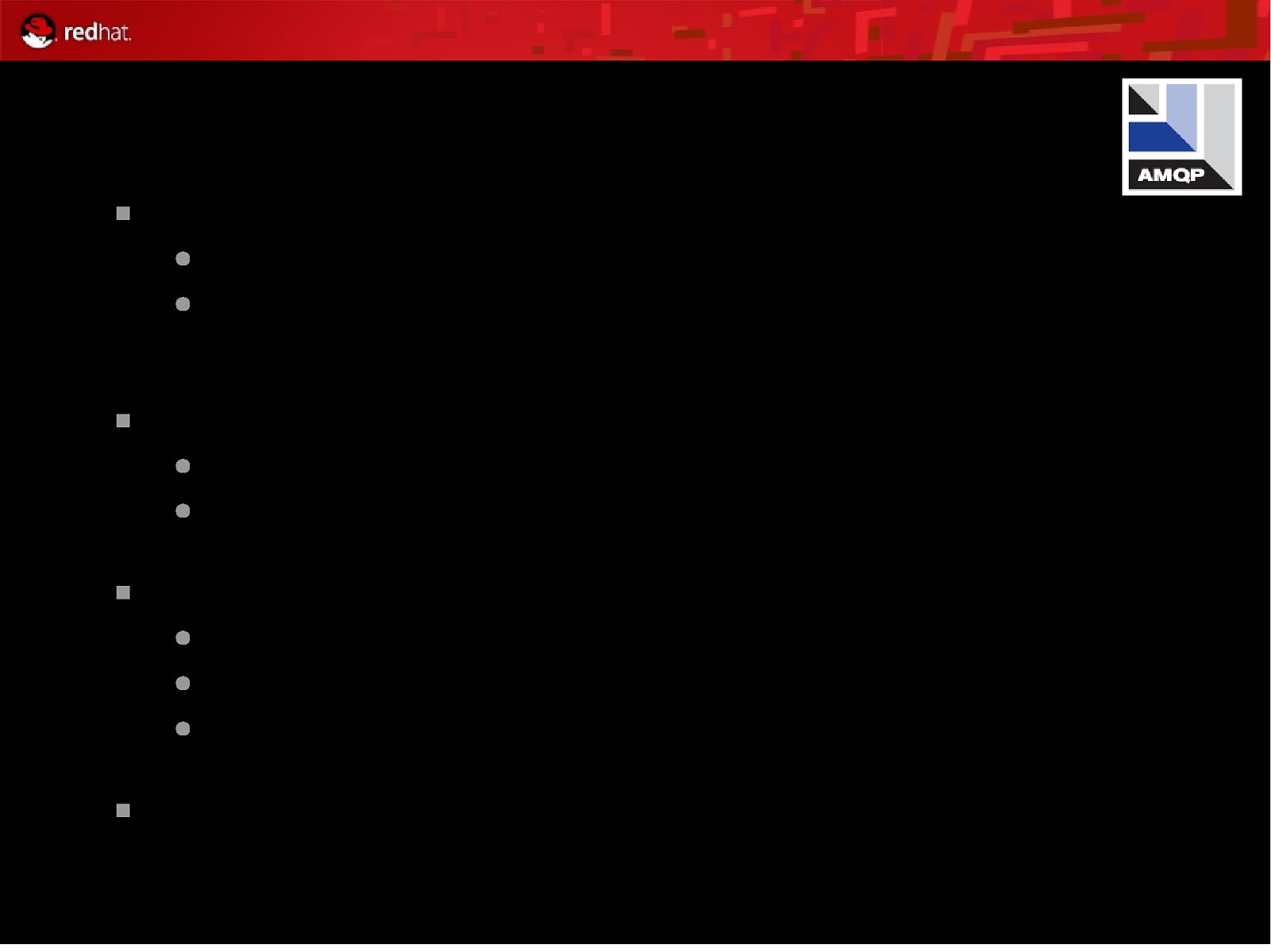
About AMQP AMQP is an open specification for messaging ● It is a complete specification ● Anyone may use the AMQP specification to create useful implementations without being charged for the IP rights to do so AMQP aims to be technology and language-neutral ● Available in C, C++, Java, JMS, .NET, C#, Ruby, Python, etc. ● Requires IP, and can be used with TCP, UDP, SCTP, Infiniband, etc. Products complying with AMQP are inter-operable ● AMQP is a Wire-Level protocol based on the ubiquitous IP ● Wire-level compatibility means it can be embedded in the network ● Applications written to Product X will plug into servers running Product Y Red Hat is a founding member of the AMQP Working Group 68
Slide 69

MRG: Enables applications and transactions to run predictably, with guaranteed response times ● Realtime Provides microsecond accuracy Provides competitive advantage & meets SLA’s ● Travel web site: missed booking ● Program trading: missed trades ● Command & Control: life & death Provides replacement kernel for RHEL 5.1+; x86/x86_64 Preserves RHEL Application Compatibility 69
Slide 70

Detail zoom-in of RHEL5 vs MRG Realtime Red Hat Confidential
Slide 71

MRG: Realtime Tools MRG includes a new MRG Realtime Latency Tracer ● Runtime trace capture of longest latency codepaths – both kernel and application. Peak detector ● Selectable triggers for threshold tracing ● Detailed kernel profiles based on latency triggers Existing standard RHEL5 based performance monitoring tools remain relevant ● Gdb, OProfile Frysk – source level debuggers & profiler ● SystemTap, kprobe – kernel event tracing and dynamic data collection ● kexec/kdump standard kernel dump/save core capabilities 71
Slide 72
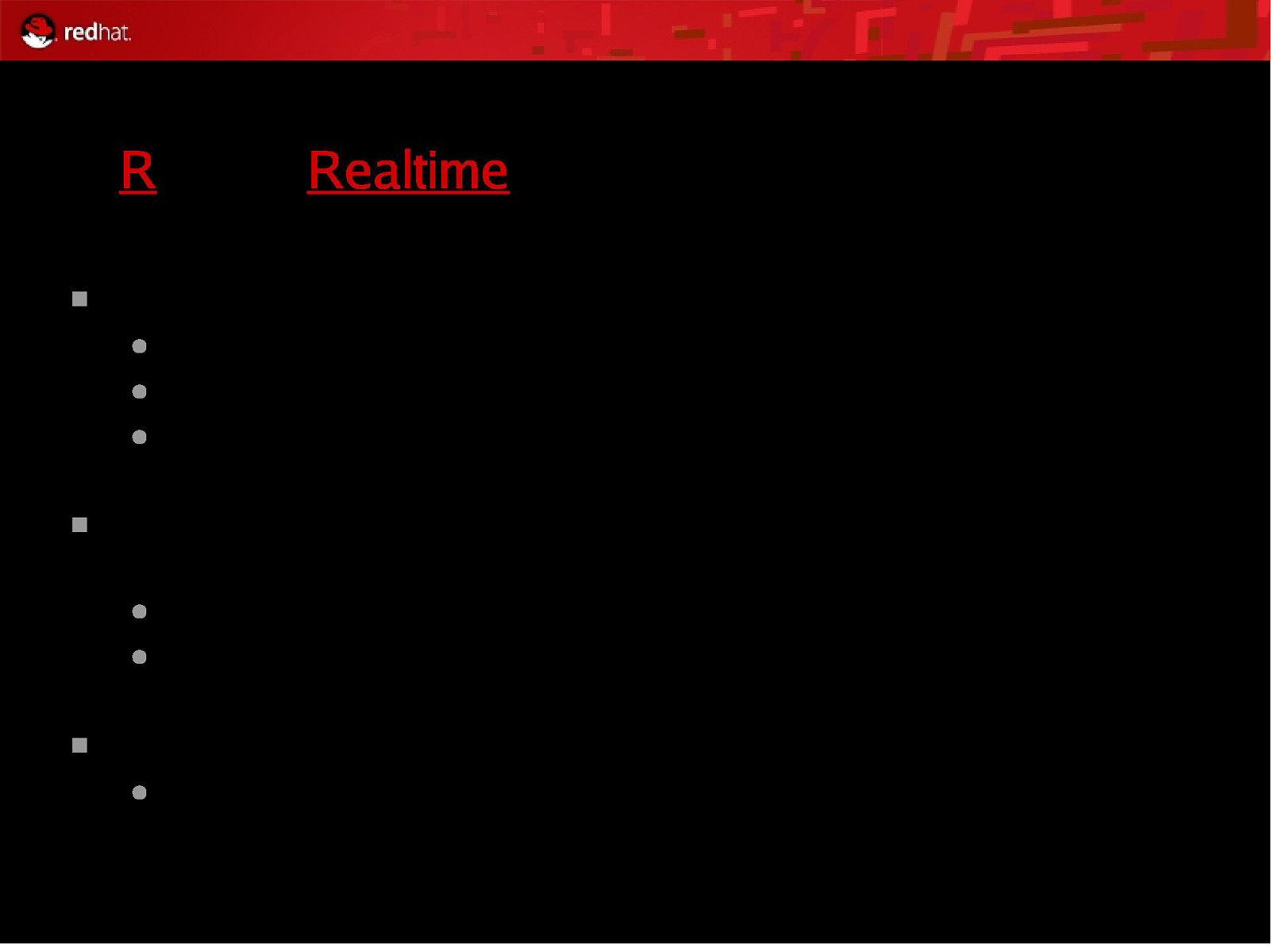
MRG: Realtime Breakthroughs Red Hat engineers succeed at mainstream acceptance ● Methodical multi-year implementation ● Incrementally added features beneficial to all use cases ● Iteratively worked to cooperatively build an inclusive realtime community MRG Realtime is COTS (Commercial Off The Shelf) operating system ● Standard RHEL5.1 OS ● Replacement kernel Integrated with distributed high speed messaging & grid scheduler ● MRG Messaging, MRG Grid 72
Slide 73
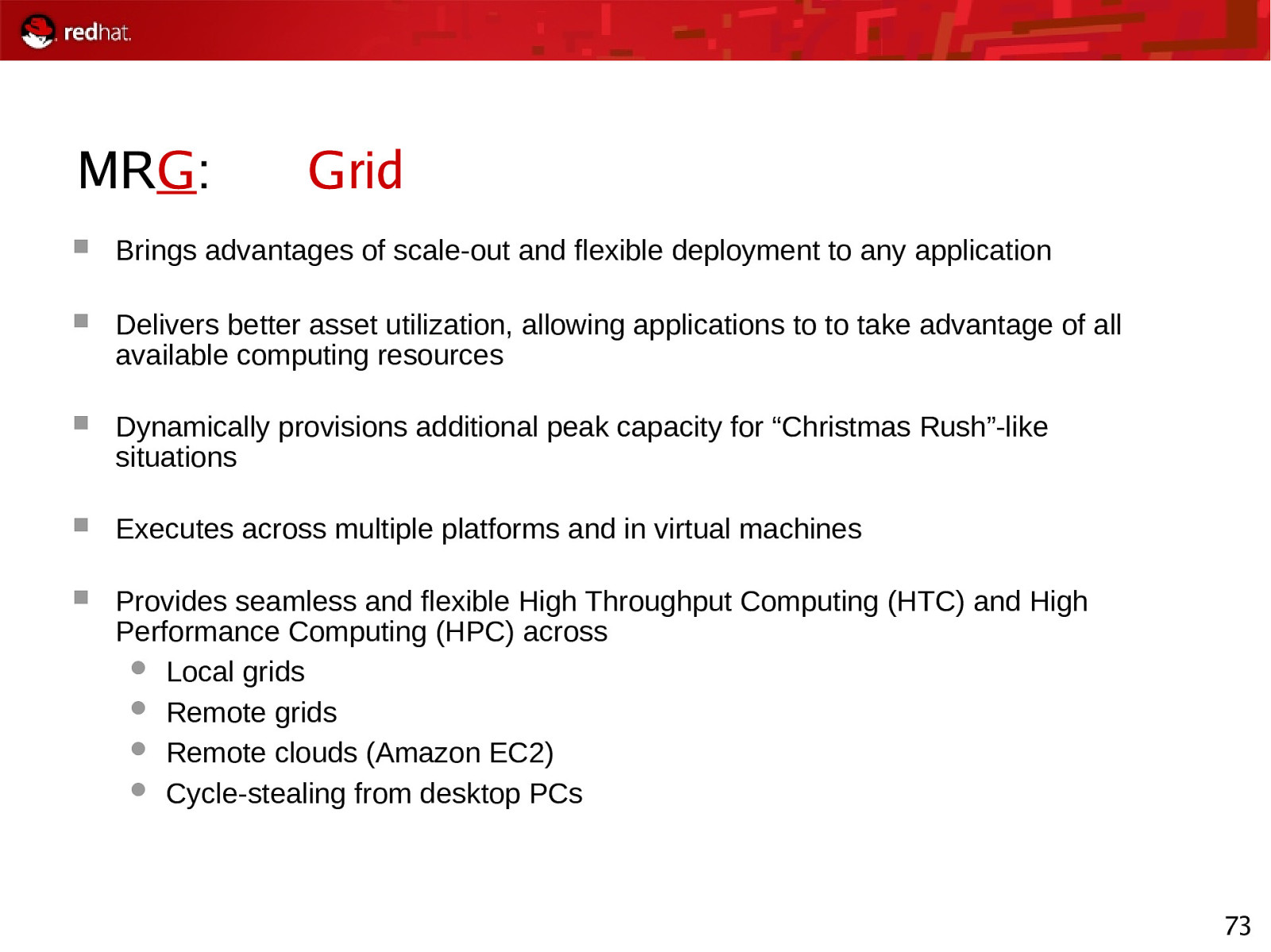
MRG: Grid Brings advantages of scale-out and flexible deployment to any application Delivers better asset utilization, allowing applications to to take advantage of all available computing resources Dynamically provisions additional peak capacity for “Christmas Rush”-like situations Executes across multiple platforms and in virtual machines Provides seamless and flexible High Throughput Computing (HTC) and High Performance Computing (HPC) across Local grids Remote grids Remote clouds (Amazon EC2) Cycle-stealing from desktop PCs 73
Slide 74

MRG: Grid based off Condor MRG Grid is based on the Condor Project created and hosted by the University of Wisconsin, Madison Red Hat and the University of Wisconsin have signed a strategic partnership around Condor: University of Wisconsin makes Condor source code available under OSIapproved open source license Red Hat & University of Wisconsin jointly fund and staff Condor development on-campus at the University of Wisconsin Red Hat and the University of Wisconsin’s partnership will: Add enhanced enterprise features, management, and supportability to Condor and MRG Grid Add High Throughput Computing capabilities to Linux 74
Slide 75

Red Hat Enterprise MRG Availability MRG Announcement & Beta Launch: December 2007 Public beta MRG v1.0: Early 2008 RHEL-only support for MRG Messaging broker MRG Grid Technology Preview MRG v1.1: Late 2008 Multi-platform support for MRG Messaging Java-based broker AMQP support updated to newly available AMQP version (1.0) MRG Grid support available 75
Slide 76
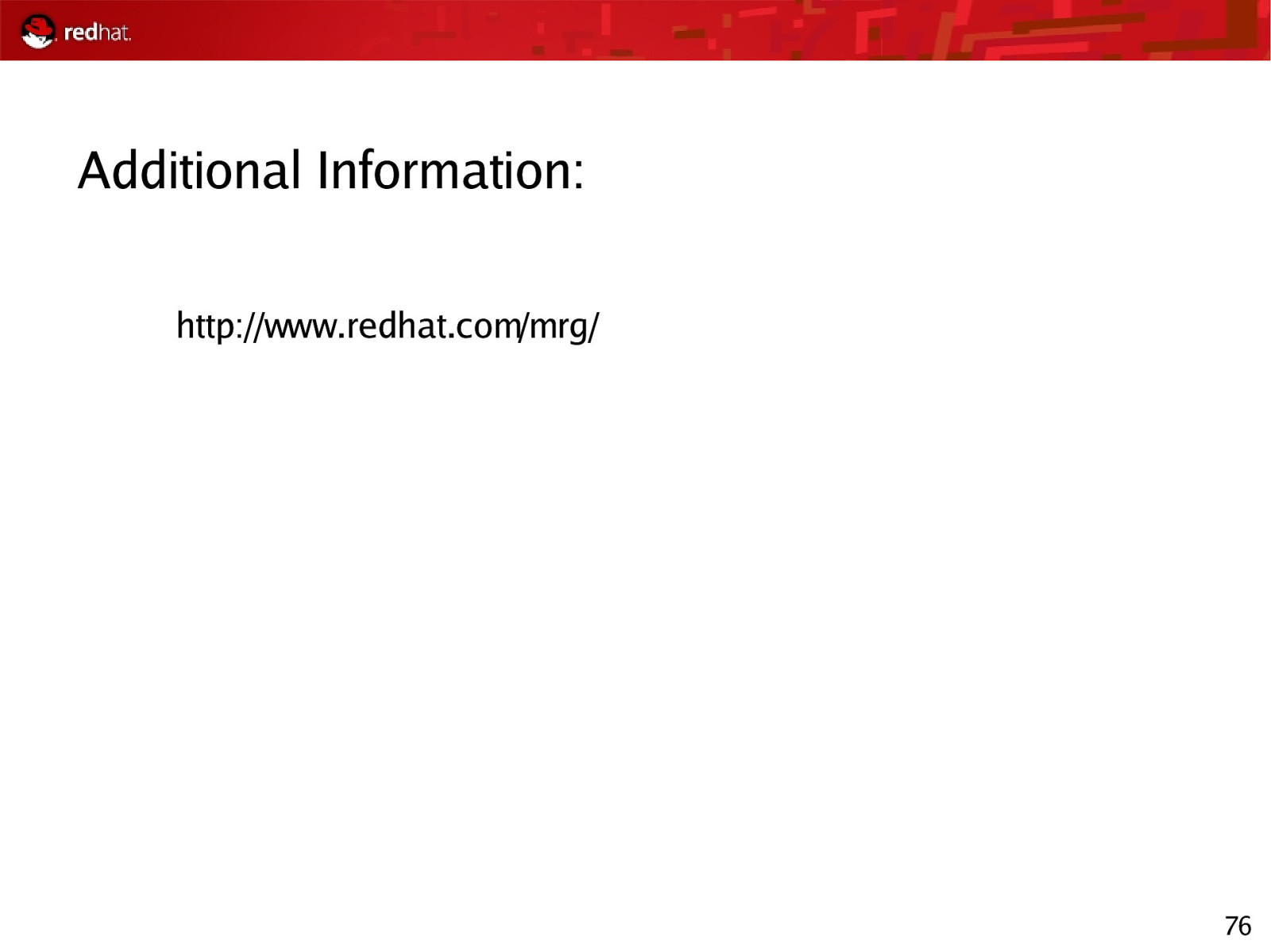
Additional Information: http://www.redhat.com/mrg/ 76
Slide 77

Security Information Situation Today Many security and security management applications store and manage their own vital security information Identity Policy Audit Difficult to analyze across applications, so organizations can’t Form a full picture of their security stance Comply with government regulations Protect themselves sufficiently Efficiently enable their operations Example: Identity silos 77
Slide 78
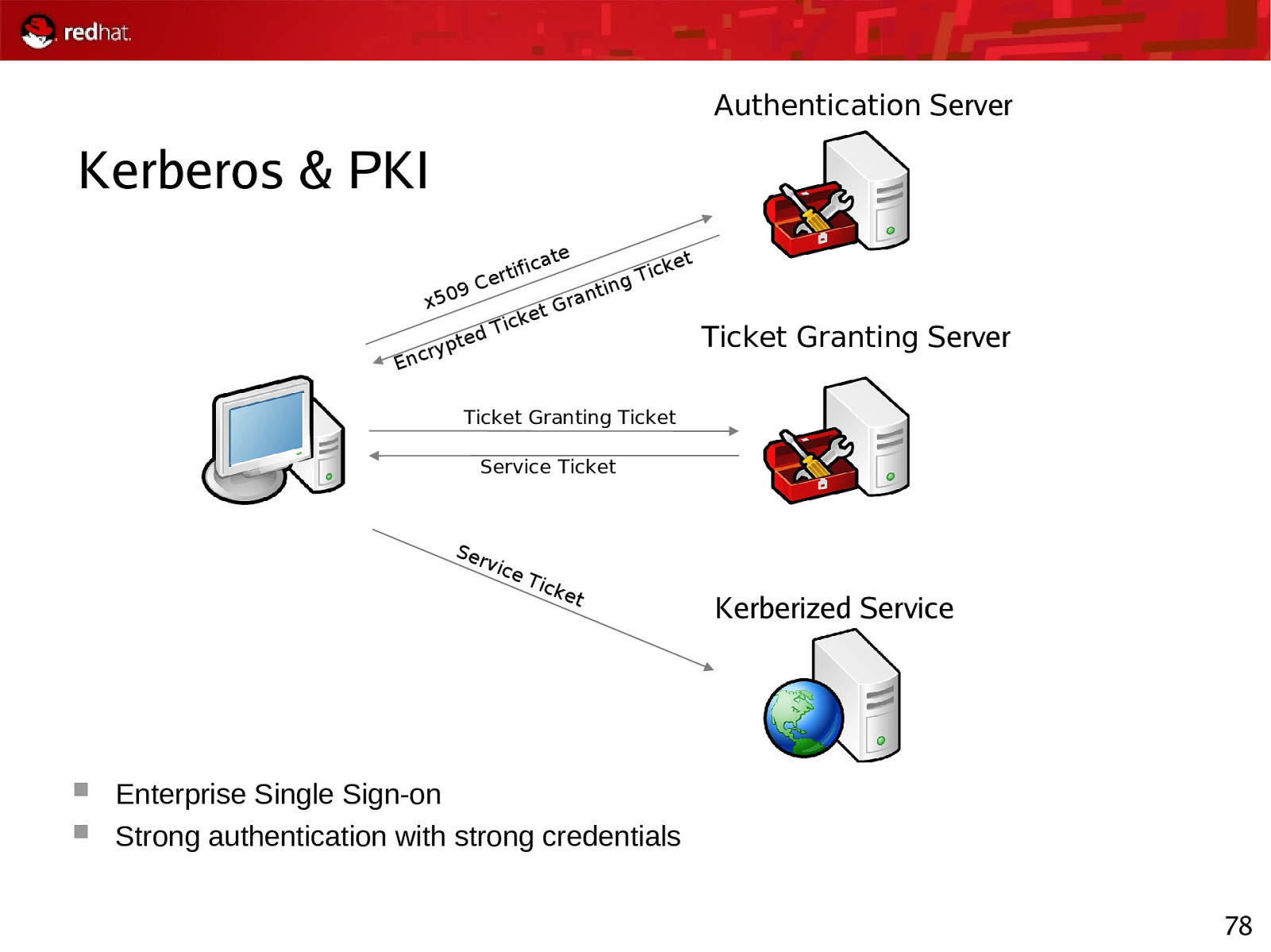
Authentication Server Kerberos & PKI ate x50 9C d pte ry Enc fic erti t icke T g tin ran G et Tick Ticket Granting Server Ticket Granting Ticket Service Ticket Ser v ice Tic ket Kerberized Service Enterprise Single Sign-on Strong authentication with strong credentials 78
Slide 79

What is needed? To enable this: Maximize freedom Maximize efficiency Vital security information (IPA) should be: Open (You own it) Inter-operable Manageable Need a way to make it possible for vital security information Identity Policy Audit to enable the freedom and efficiency of next generation IT infrastructure 79
Slide 80
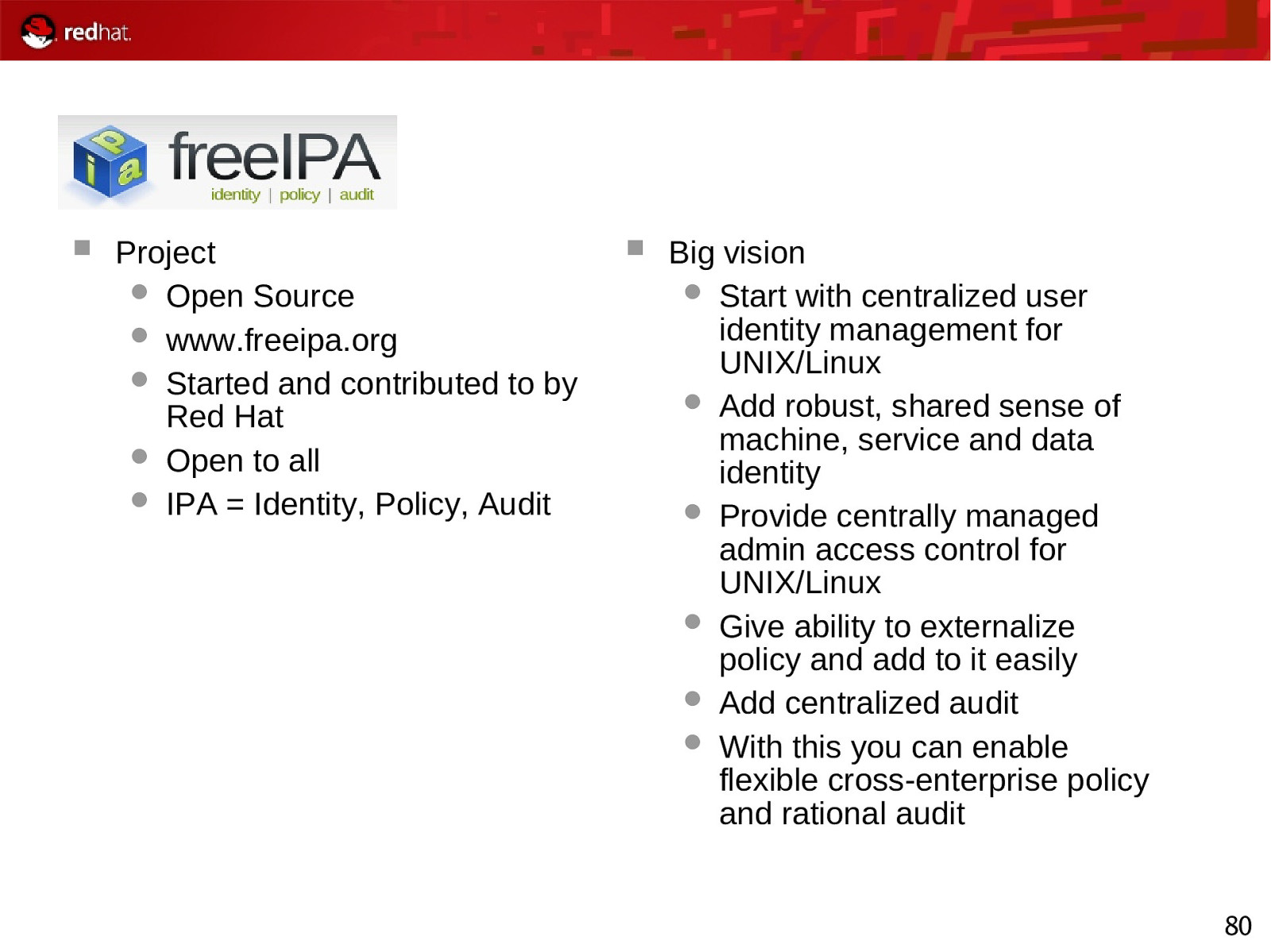
Project Open Source www.freeipa.org Started and contributed to by Red Hat Open to all IPA = Identity, Policy, Audit Big vision Start with centralized user identity management for UNIX/Linux Add robust, shared sense of machine, service and data identity Provide centrally managed admin access control for UNIX/Linux Give ability to externalize policy and add to it easily Add centralized audit With this you can enable flexible cross-enterprise policy and rational audit 80
Slide 81
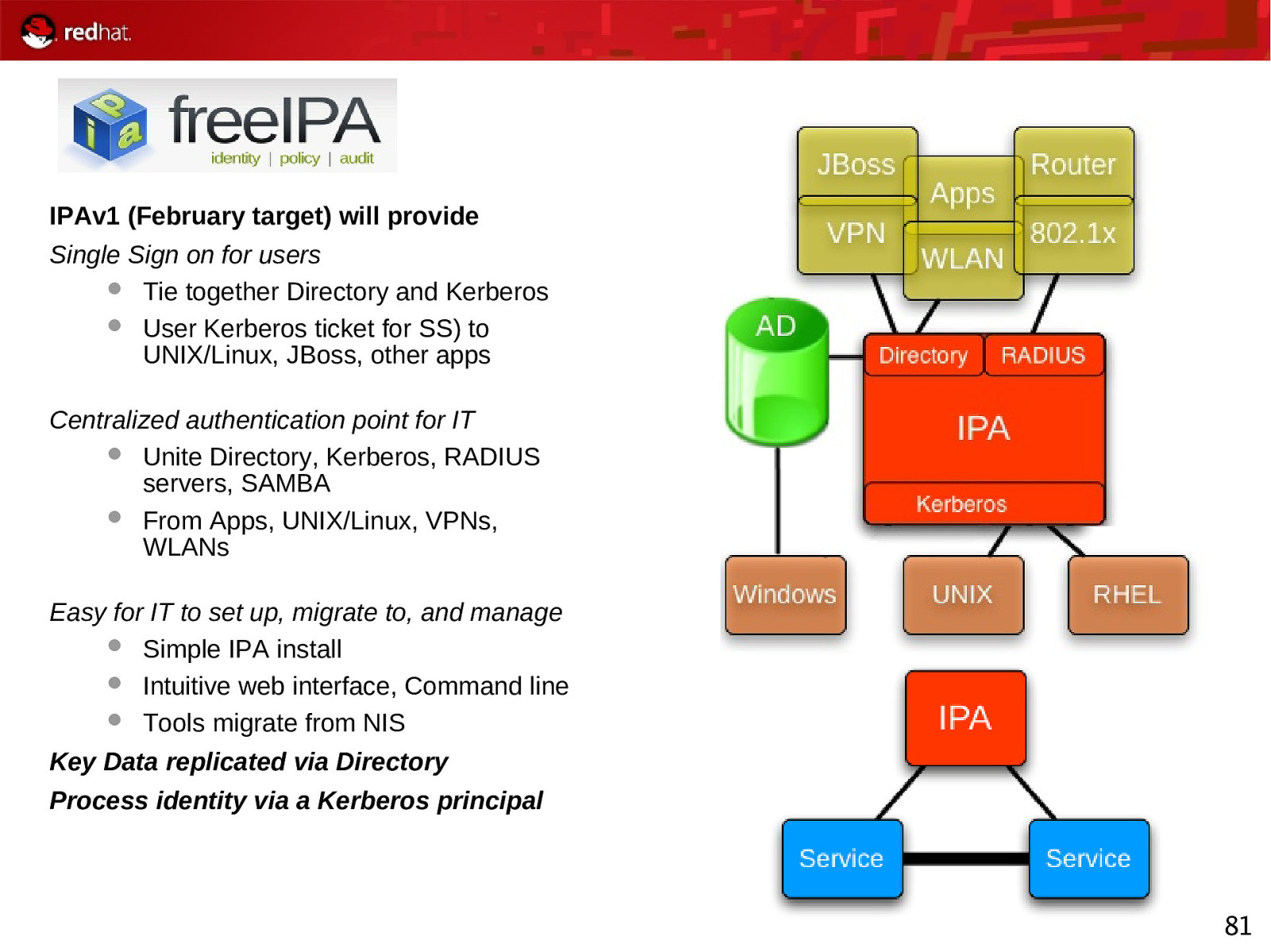
IPAv1 (February target) will provide Single Sign on for users Tie together Directory and Kerberos User Kerberos ticket for SS) to UNIX/Linux, JBoss, other apps Centralized authentication point for IT Unite Directory, Kerberos, RADIUS servers, SAMBA From Apps, UNIX/Linux, VPNs, WLANs Easy for IT to set up, migrate to, and manage Simple IPA install Intuitive web interface, Command line Tools migrate from NIS Key Data replicated via Directory Process identity via a Kerberos principal 81
Slide 82
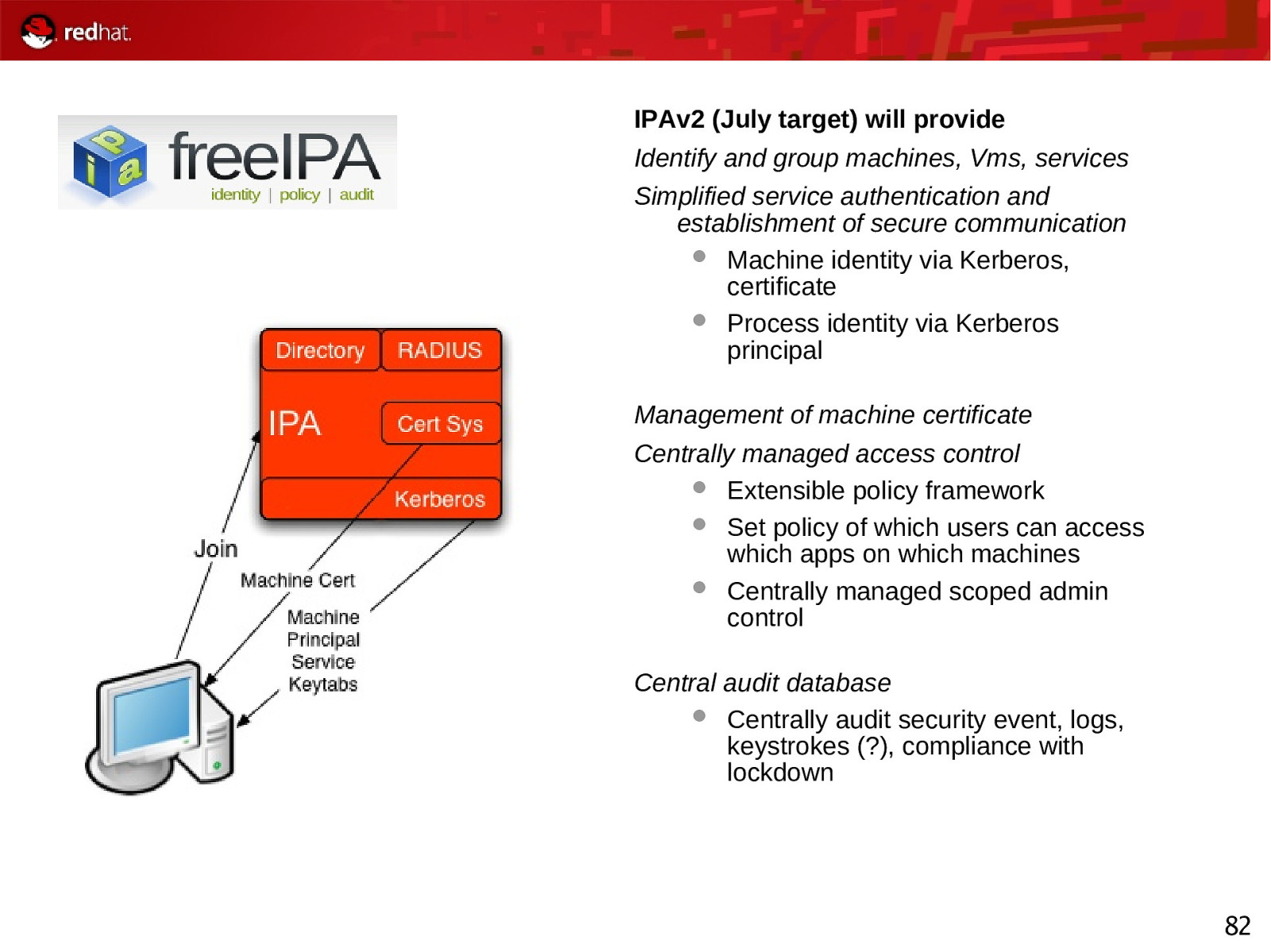
IPAv2 (July target) will provide Identify and group machines, Vms, services Simplified service authentication and establishment of secure communication Machine identity via Kerberos, certificate Process identity via Kerberos principal Management of machine certificate Centrally managed access control Extensible policy framework Set policy of which users can access which apps on which machines Centrally managed scoped admin control Central audit database Centrally audit security event, logs, keystrokes (?), compliance with lockdown 82
Slide 83
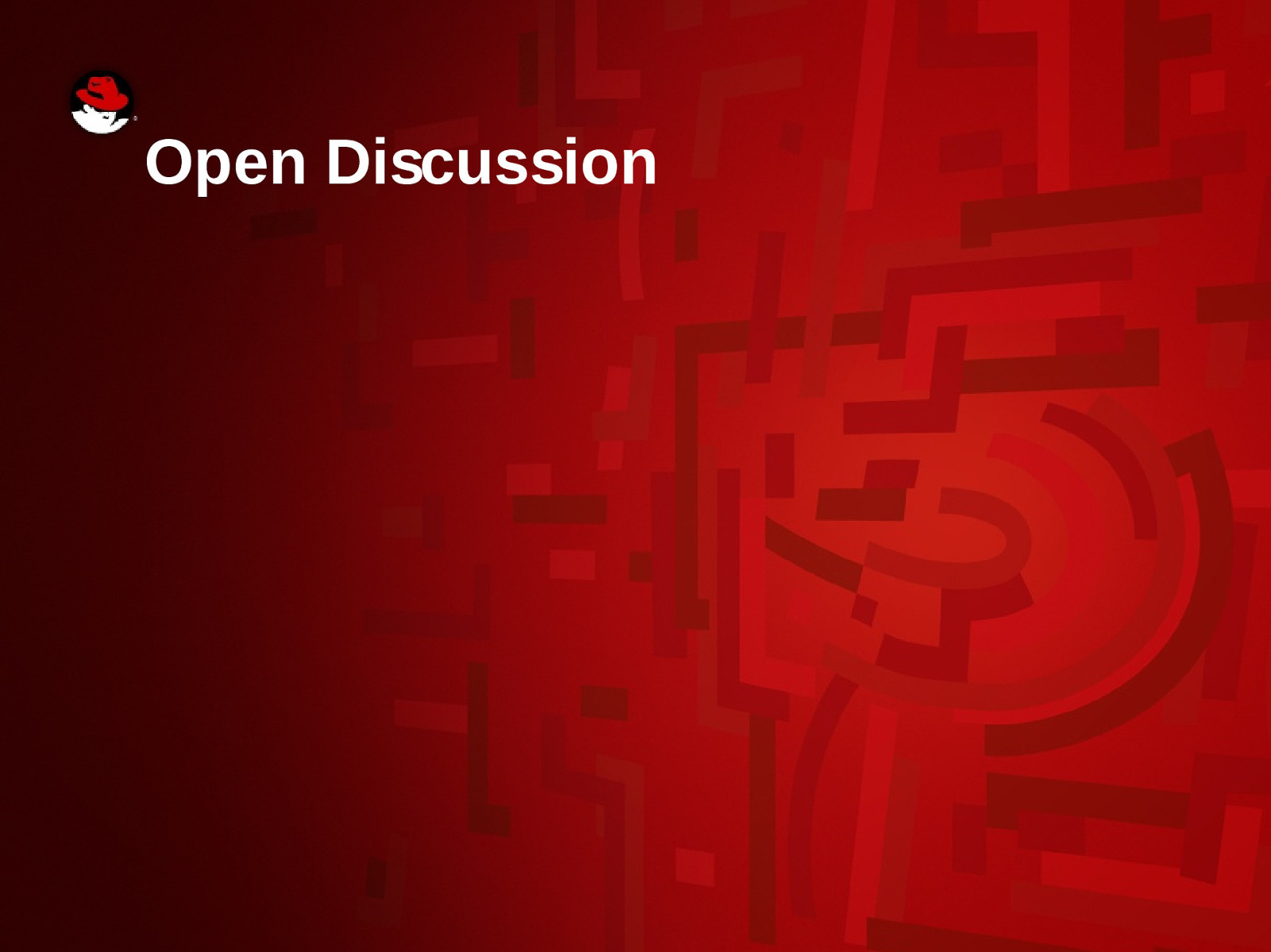
Open Discussion